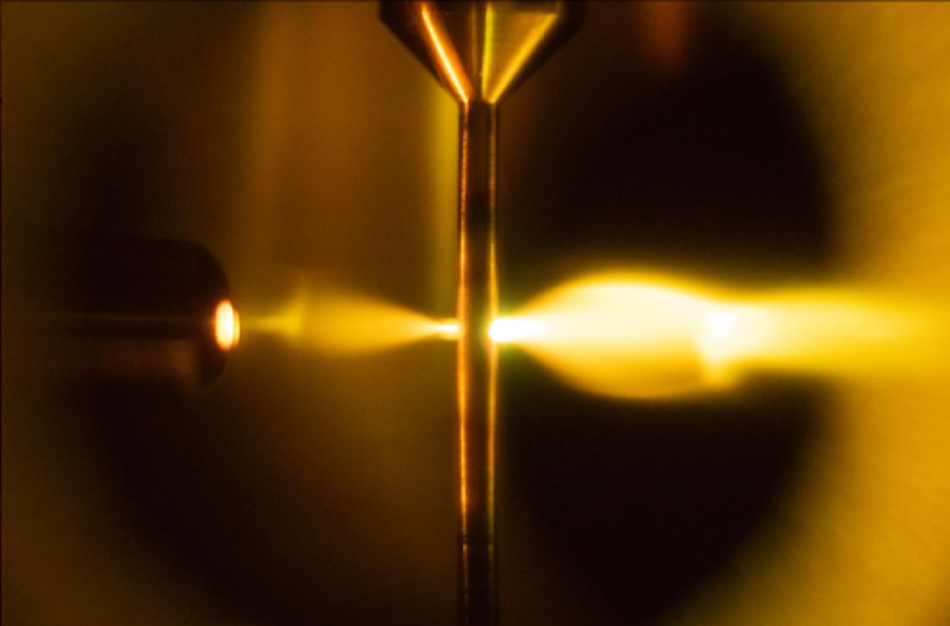Apr 9 2020
The potential to create light pulses of sub-femtosecond duration was initially demonstrated nearly two decades ago, and this ability has led to the development of attosecond science and technology, which happens to be an entirely different field.
 The photograph above is taken during the high-harmonic-generation process in the high-pressure gas cell, with the mid-infrared input arriving on the right and the soft x-ray output appearing on the left. Image Credit: ETH Zurich/D-PHYS Keller group.
The photograph above is taken during the high-harmonic-generation process in the high-pressure gas cell, with the mid-infrared input arriving on the right and the soft x-ray output appearing on the left. Image Credit: ETH Zurich/D-PHYS Keller group.
The emergence of tabletop laser systems has facilitated studies that had remained a distant dream for many years—that is, to track, image, and define electronic processes in solids, molecules, and atoms on their natural, attosecond timescales. Moreover, the tabletop laser systems that perform such analyses usually work in the extreme ultraviolet spectral band.
But for a long time, there has been a thrust to achieve higher photon energies. Here, “water window,” which is occupied by soft-X-ray radiation with wavelengths ranging from 2.2 to 4.4 nm, has attracted a considerable amount of interest.
Spectral window owes its name and significance to the fact that photons are not absorbed by oxygen (and thus by water) at those frequencies, but they are absorbed by carbon. This is perfect for analyzing biological specimens and organic molecules in their natural aqueous setting.
Although a few attosecond sources operating at this frequency range are currently available, their applicability is somewhat restricted by comparatively low repetition rates of 1 kHz or even less, which, in turn, lead to poor signal-to-noise ratios and low count rates.
Publishing in the Optica journal, Justinas Pupeikis and collaborators in the Ultrafast Laser Physics group of Professor Ursula Keller at the Institute for Quantum Electronics have now reported a major advancement in resolving the limitations of the previous sources.
The team has presented the world’s first soft-X-ray source that covers the entire water window at a repetition rate of 100 kHz—a hundred-fold enhancement when compared to that of the cutting-edge sources.
A Boost in Technological Capability
No suitable laser systems are available to propel the crucial process that is fundamental for producing attosecond pulses in the tabletop laser systems, and this limitation makes it difficult to produce soft X-rays at high repetition rates. This key process is referred to as high-harmonic generation, and it involves a powerful femtosecond laser pulse communicating with a target, usually an atomic gas.
Due to the target’s nonlinear electronic response, attosecond pulses are subsequently emitted at an odd-order multiple of the frequency of the driving laser field. The femtosecond source should work in the mid-infrared range to make sure that that response includes X-ray photons covering the water-window range. It also needs to send high-peak-power pulses and everything at high repetition rates. So far, such a source has never existed.
Pupeikis and the team accepted the challenge and proceeded to methodically enhance a layout that they had already studied in previous researches, based on optical parametric chirped-pulse amplification, also called OPCPA for short. The researchers had already established that this is a promising technique, with an aim to achieve high-power mid-infrared sources.
However, considerable enhancements still had to be made to achieve the performance needed for the high-harmonic generation of X-ray photons in the water window. The team particularly pushed the peak power from 6.3 to 14.2 GW, reaching an average power of 25 W for pulses that are slightly longer than two oscillations of the fundamental optical field (16.5 fs). The peak power shown is easily the highest reported so far for any type of high-repetition-rate system that has a wavelength greater than 2 μm.
With the availability of this level of performance, the researchers are prepared for the following stage, that is, frequency upconversion via high-harmonic generation. To accomplish the same, the OPCPA’s output beam was routed through a periscope system to another laboratory located over 15 m away, to compensate for local laboratory-space limitations. There, the beam encountered a helium target, maintained at a pressure of 45 bar.
Such high pressure was required for phase-matching between the X-ray and the infrared radiations, and then for improved energy-conversion efficiency.
With all the pieces meticulously put in place, the system certainly delivered. It produced coherent soft X-ray radiation that extends to an energy of 620 eV (a wavelength of 2 nm), spanning the entire water window—a breakthrough achievement in relation to other high-repetition-rate sources in this frequency range.
A Window of Opportunity
This latest demonstration paves the way for a wide variety of new opportunities. Coherent imaging in the spectral region of the water window is extremely relevant for biology and chemistry and could be achieved with a compact setup.
The availability of a high repetition rate also helps, for example, in dealing with the constraints caused by space-charge formation, which continues to impact photoemission experiments with pulsed sources. In addition, the “water window” contains the K-edges of oxygen, nitrogen, and carbon as well as the M- and L-edges of many different metals, which can be analyzed at present with higher specificity or sensitivity.
With all these immense opportunities, the recent demonstration to realize the soft-X-ray source could usher in the beginning of revolutionary attosecond technology, one where experimentalists could make integrated use of high photon energies and high repetition rates, for the first time.
The Keller laboratory is currently developing an attosecond beamline to manipulate these novel capabilities.